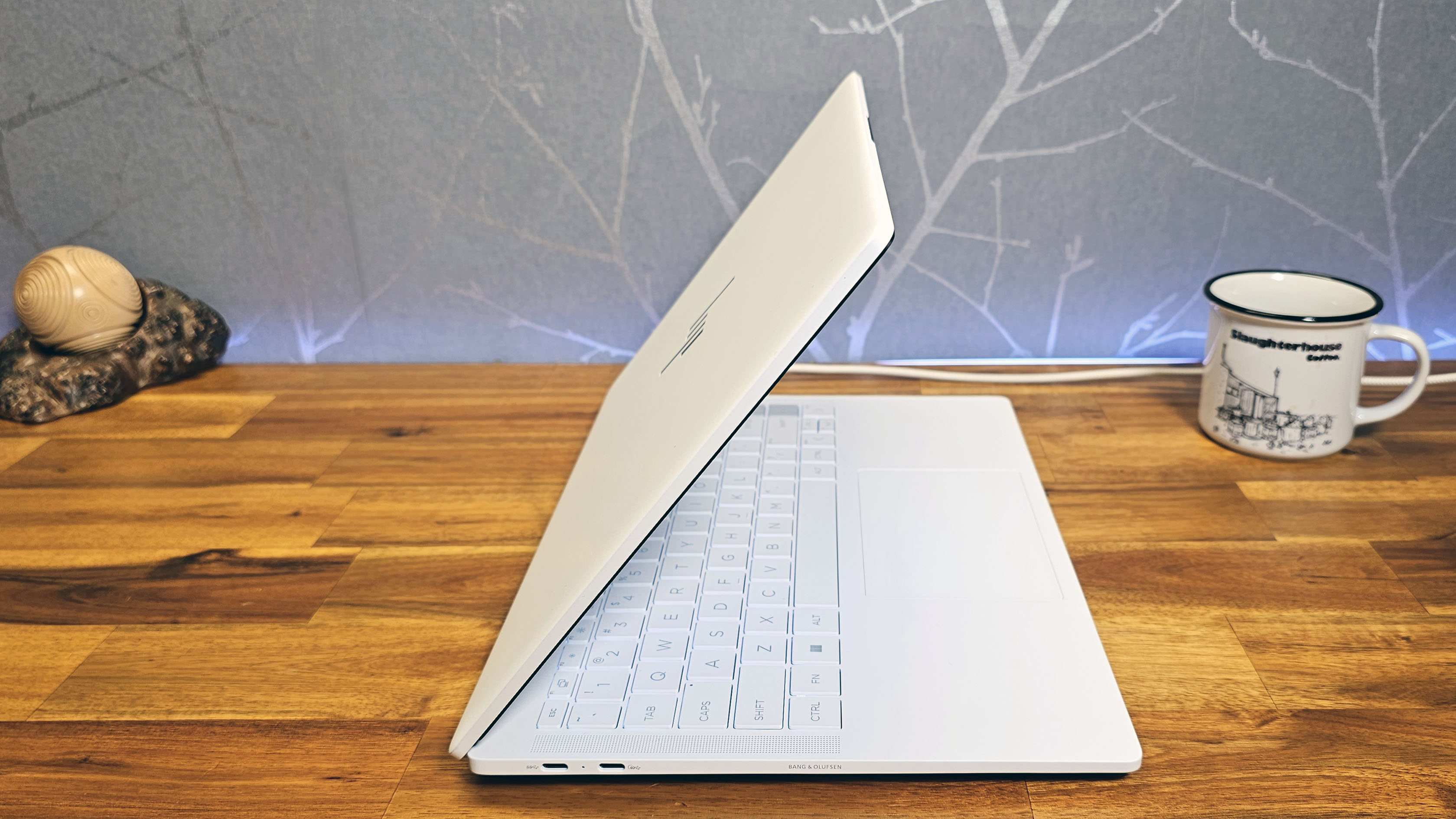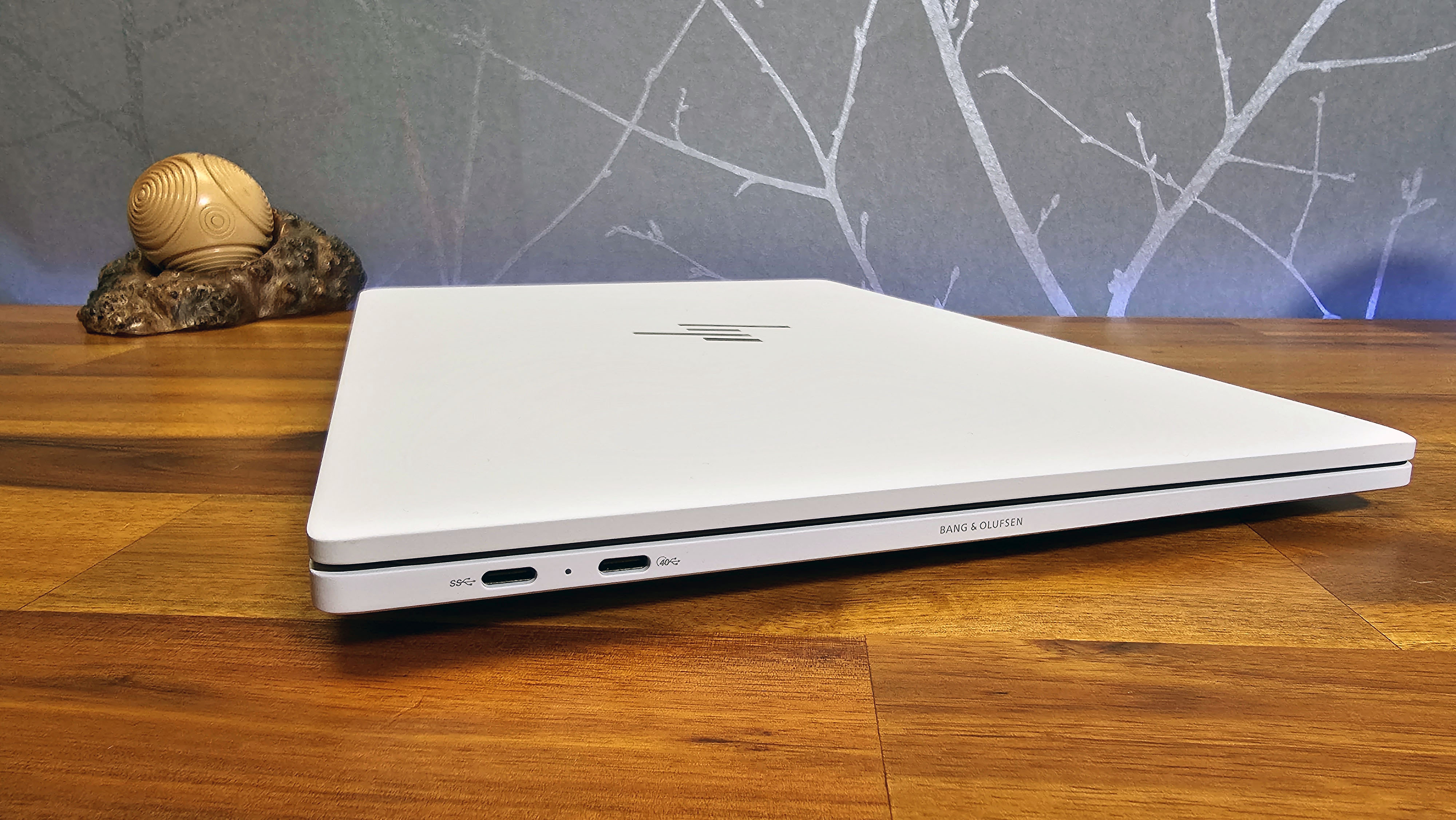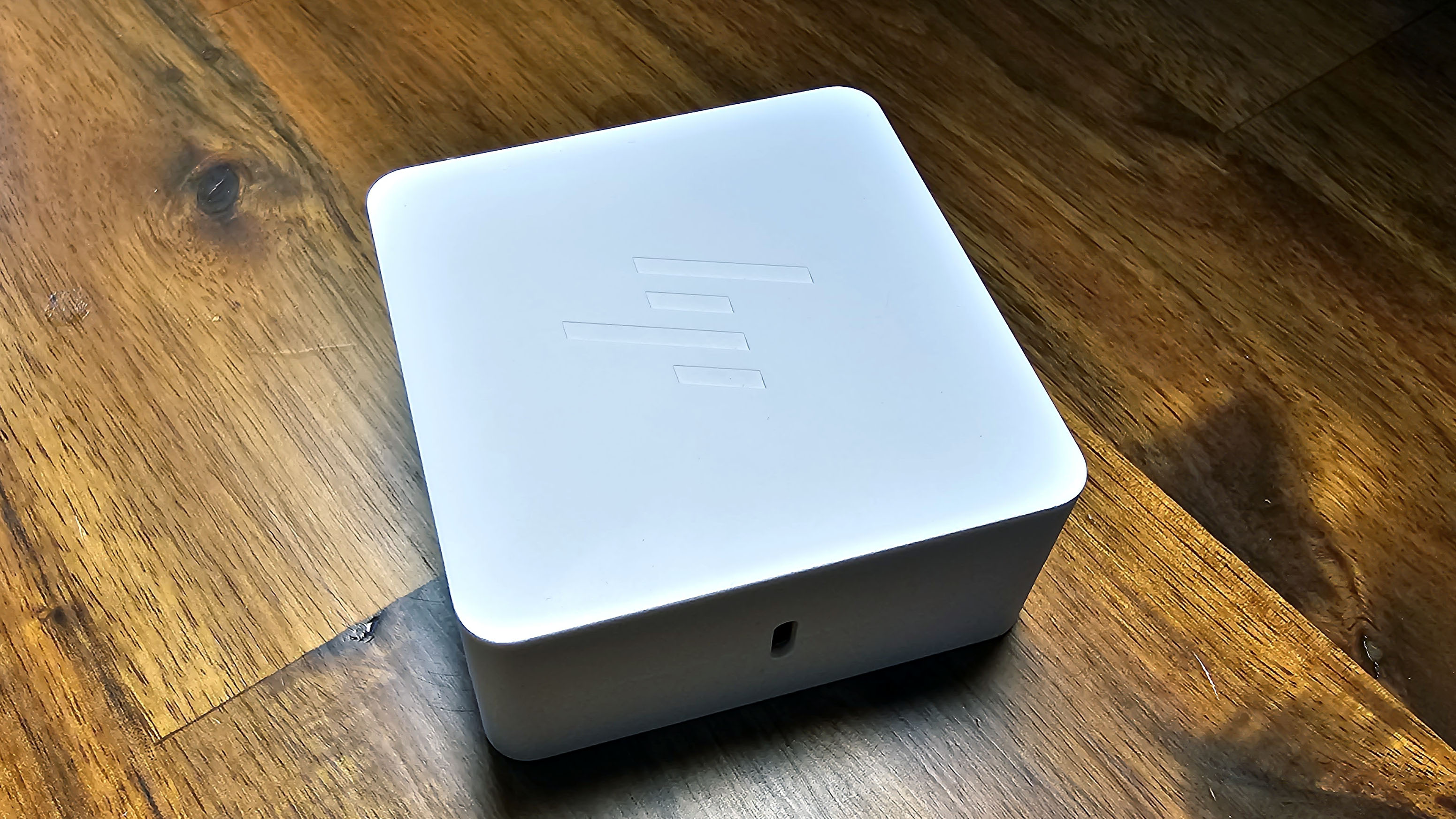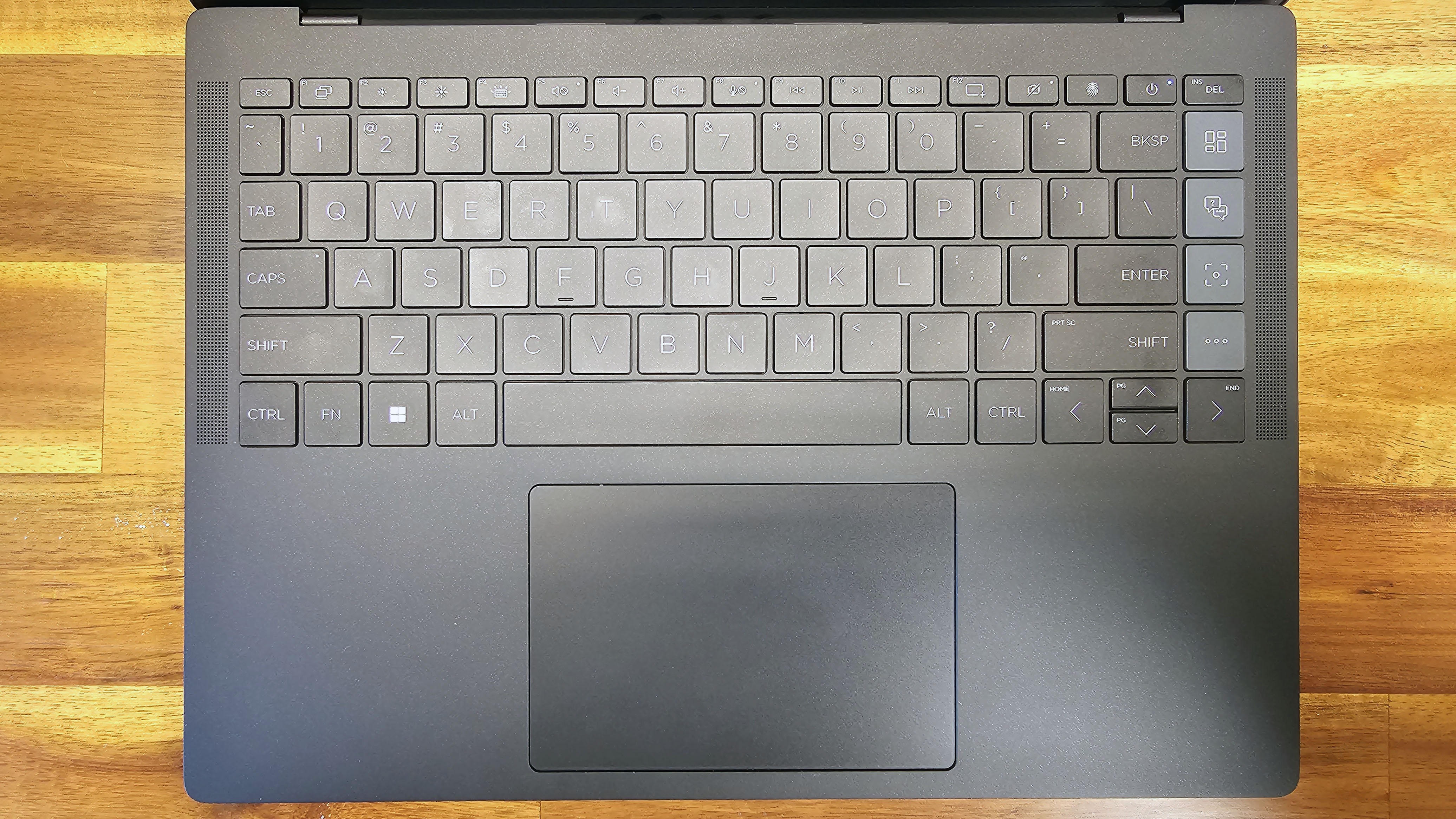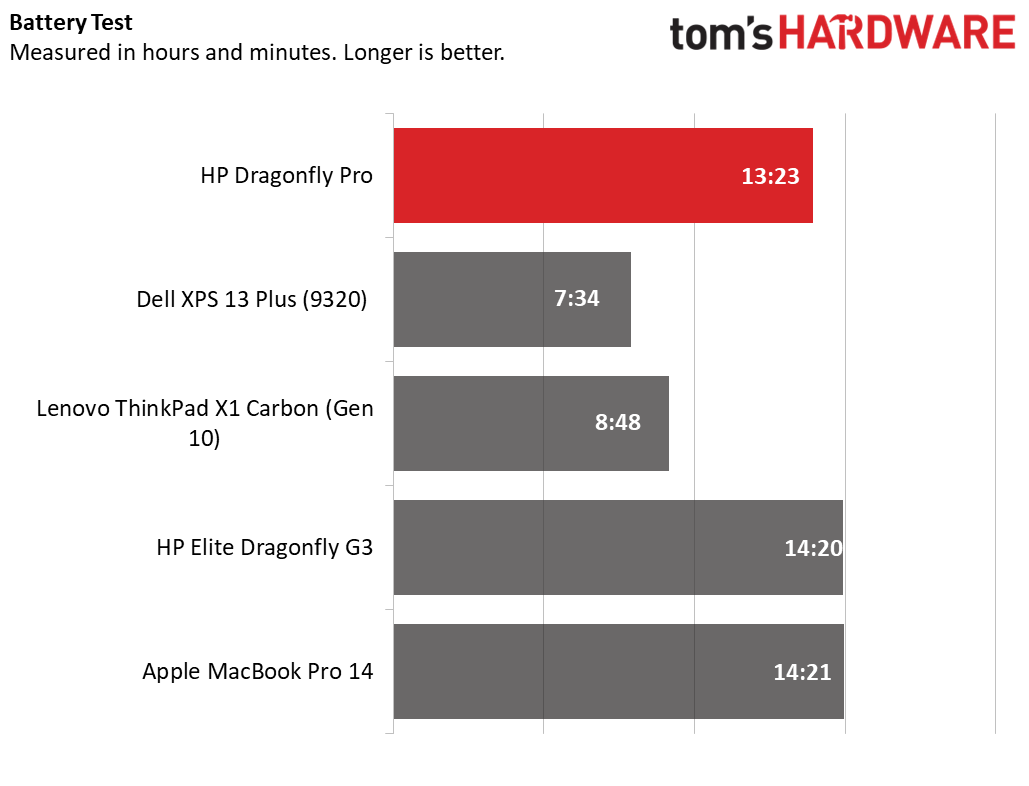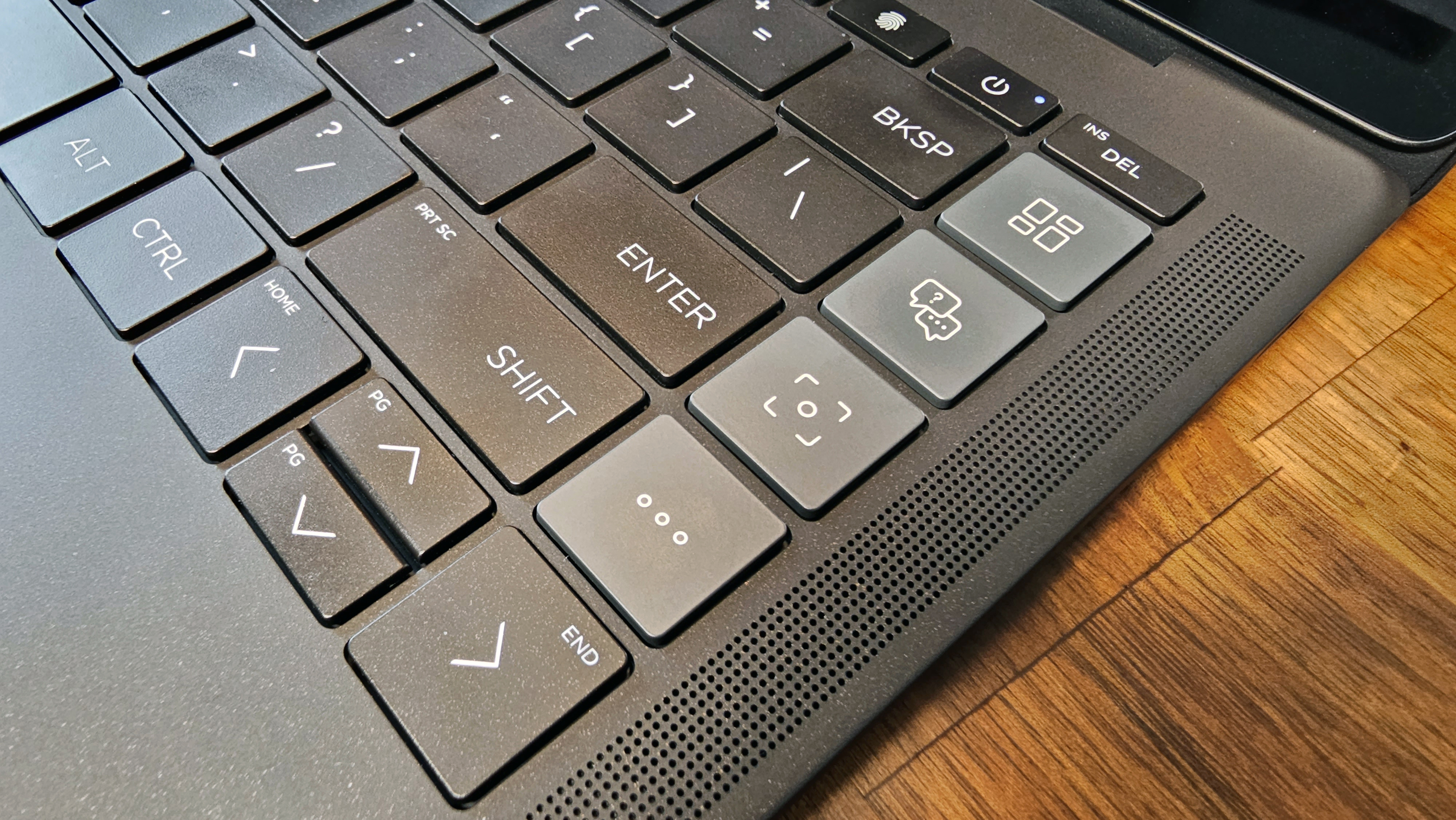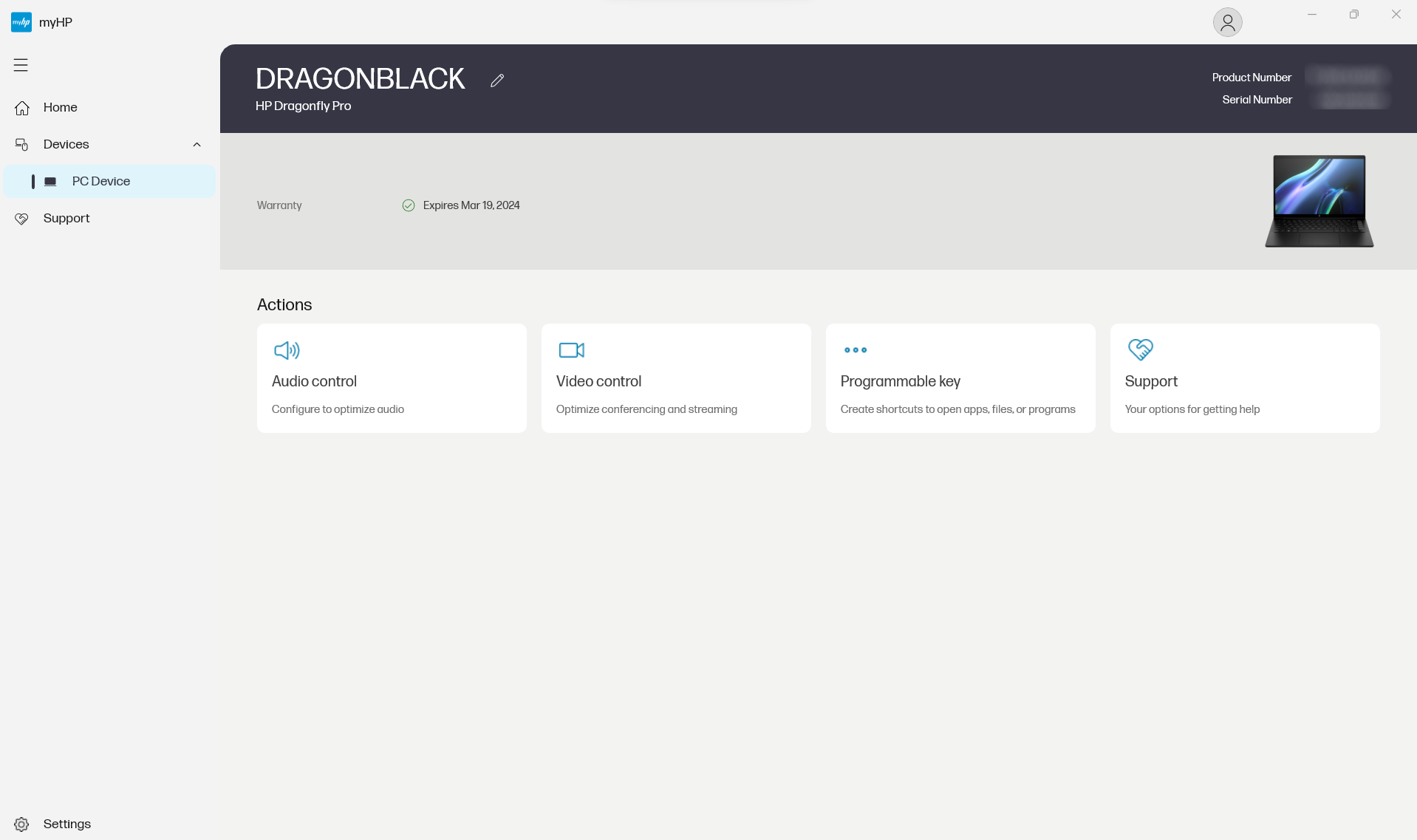Tom's Hardware Verdict
HP's Dragonfly Pro is a pretty laptop that shops with a year of 24/7 on-demand support. HP says it's aimed at non-tech-savvy freelancers. But starting at $1,399 and weighing over 3.5 pounds, it doesn't seem particularly well suited to on-the-go users in the often cash-strapped world of the gig economy.
Pros
- +
Attractive design
- +
Bright, colorful touch display
- +
24/7 premium support
- +
Strong battery life in our testing
Cons
- -
Persistent battery drain/sleep issues
- -
Expensive and heavy for a laptop aimed at freelancers
- -
myHP software is slow and clunky
- -
No USB-A ports, despite being fairly thick
Why you can trust Tom's Hardware
In early 2023, HP expanded its previously ultraportable Dragonfly lineup to include a pair of larger, somewhat heavier 14-inch Dragonfly Pro clamshells, one a Chromebook with a super-bright screen, the other an AMD-based Windows machine. Both models come with a year of 24/7 tech support via dedicated buttons. We're looking at the Windows model here, and while the HP Dragonfly Pro is nicely designed and decently performing for its $1,399 (as configured) asking price, I'm not really sure who it's for.
HP says its Dragonfly Pro laptops are aimed at freelancers who might get overwhelmed by tech specs and configuration options. To that end, the Windows model comes in just two options, both with the same AMD Ryzen 7 7736U CPU. This is technically a new CPU, though it uses an older Zen 3+ architecture, rather than the Zen 4 found in higher-end Ryzen 7000 'Dragon Range' CPUs. But the starting price of $1,399 seems like a lot for those entrenched in the gig economy.
HP also seems to be aiming at former MacBook users with its design, plus a year of included live support for those who struggle with basic tasks – the myHP app has guides for things like changing your background or taking a profile photo. And HP repeatedly compared the Dragonfly Pro to the 14-inch MacBook Pro in discussions about the laptop, but it's unclear why anyone would jump ship from Apple now. The company's Arm-based silicon puts MacBook performance and efficiency in a better place than it's arguably ever been.
Design of the HP Dragonfly Pro
The design of the HP Dragonfly Pro is attractively minimal. Available in either black or white, with a magnesium and aluminum frame (to varying degrees recycled, as is the plastic of the keycaps), the laptop both looks and feels premium, if a bit uniformly uninteresting. I miss the dark blue of previous Dragonfly laptops. But the modern mirrored HP logo on the lid does look nice – at least as big company logos go.
The laptop feels slimmer than its 0.72 x 12.39 x 8.78-inch chassis – in part because a raised rubber leg holds the rear of the laptop off the table or desk, presumably for improved cooling. But at 3.53 pounds, it's heavier than I'd like – especially if I were the kind of on-the-go freelancer that HP says it's targeting with this device. Then again, Apple's MacBook Pro 14 is similar in size and weight, at 12.3 x 8.7 x 0.6 inches and 3.5 pounds.
And if you're the kind of freelancer who likes to plug things into your PC, you better have a hub/dongle or USB-C everything. Because that's all you're getting when it comes to ports. The right edge houses a USB 4 Type-C port (40 Gbps), while the left edge accommodates two USB-C ports, one USB 4 and one USB 3.2 (10 GBps).
This is another area where it feels like HP is attempting to emulate MacBook design. Although it goes a bit further by also eliminating the headphone jack. But we've seen plenty of thinner Windows laptops with USB-A ports and we're sure plenty of people would appreciate (at least) one included here. Lenovo's ThinkPad X1 Carbon, for instance, is just 0.59 inches thick and makes room for two USB-A ports and HDMI. It also weighs a pound less than the Dragonfly Pro and starts at $1165.
There's not a whole lot more to say about the Dragonfly Pro's design. The black model reminds me a bit of Razer's Blade 14 in its premium but otherwise plain dark exterior design. And, this is admittedly a minor gripe, but the daily commuter I used to be worries about the odd and seemingly unnecessary gap between the base and the lid in the rear corners. This is at least partially caused by a raised lip that runs around the screen, protecting the display from the base of the unit when closed. But seeing a gap between halves of the laptop doesn't exactly scream premium, and I wonder about what funk might accumulate there and in the rear vent area that's open when the laptop is closed.
One thing I do appreciate about the overall design of the Dragonfly Pro is that HP includes a compact, square GaN (gallium nitride) 96W charger in the box, along with a removable braided USB-C cable. In a perfect world, I'd like to have seen another USB-C or USB-A port on the charger (or why not both?) so you could charge your phone or another device with this single charger on the go. But the charger here is still nicer and more travel-friendly than anything I've seen included with any laptop lately. I'm so ready for the traditional laptop brick to be relegated to the realm of laptops past.
HP Dragonfly Pro Specifications
| CPU | AMD Ryzen 7 7736U |
| Graphics | AMD Radeon 680M (integrated) |
| Memory | 16GB LPDDR5 |
| Storage | 512GB NVMe SSD (soldered) |
| Display | 14-inch, 1920 x 1200 touchscreen |
| Networking | Qualcomm WCN685x Wi-Fi 6E, Bluetooth 5.2 |
| Ports | 2x USB4 (40 GBps), 1x USB Type-C 3.2 (10 GBps) |
| Camera | 5MP, with IR |
| Battery | 65 WHr |
| Power | Adapter 330 W |
| Operating System | Windows 11 Home |
| Dimensions (HxWxD) | 0.72 x 12.39 x 8.78 inches |
| Weight | 3.53 pounds (1.6 kg) |
| Price (as configured) | $1,399 |
Productivity Performance on the HP Dragonfly Pro
With the 8-core AMD Ryzen 7 7736U CPU and 16GB of RAM in our test configuration, I was interested to see how the Dragonfly's performance would stand up to modern Apple- and Intel-based competition. And for the most part, while it doesn't consistently lead, it generally holds its own, with stronger results in our multi-core tests than in lightly threaded workloads.
Get Tom's Hardware's best news and in-depth reviews, straight to your inbox.

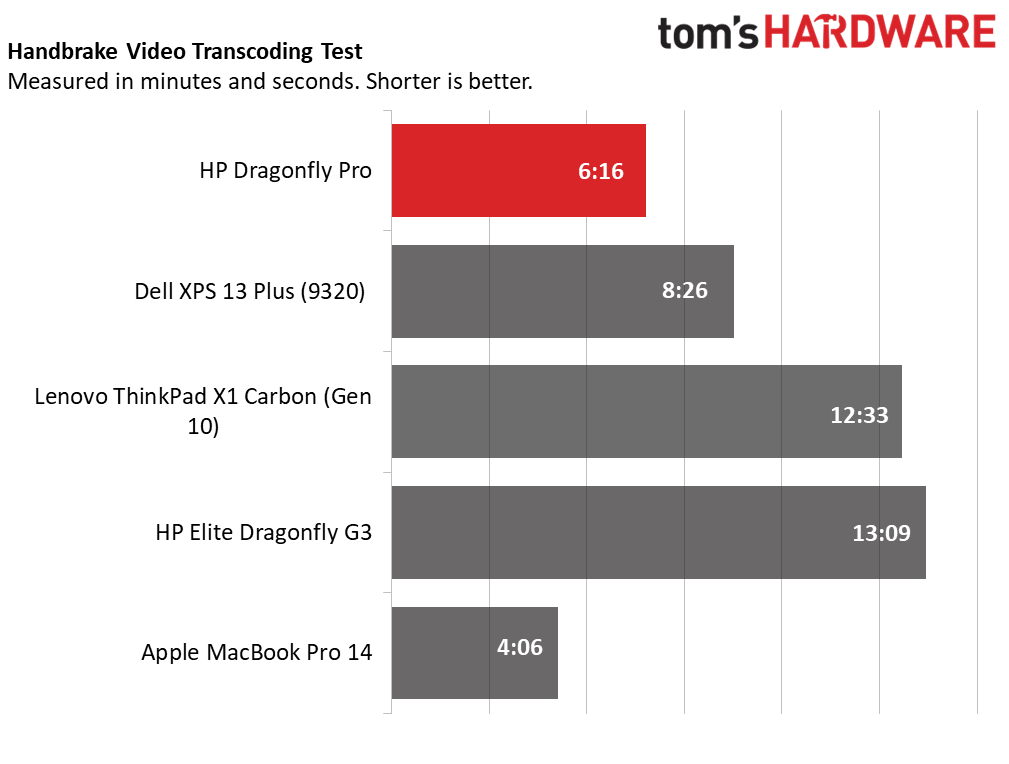
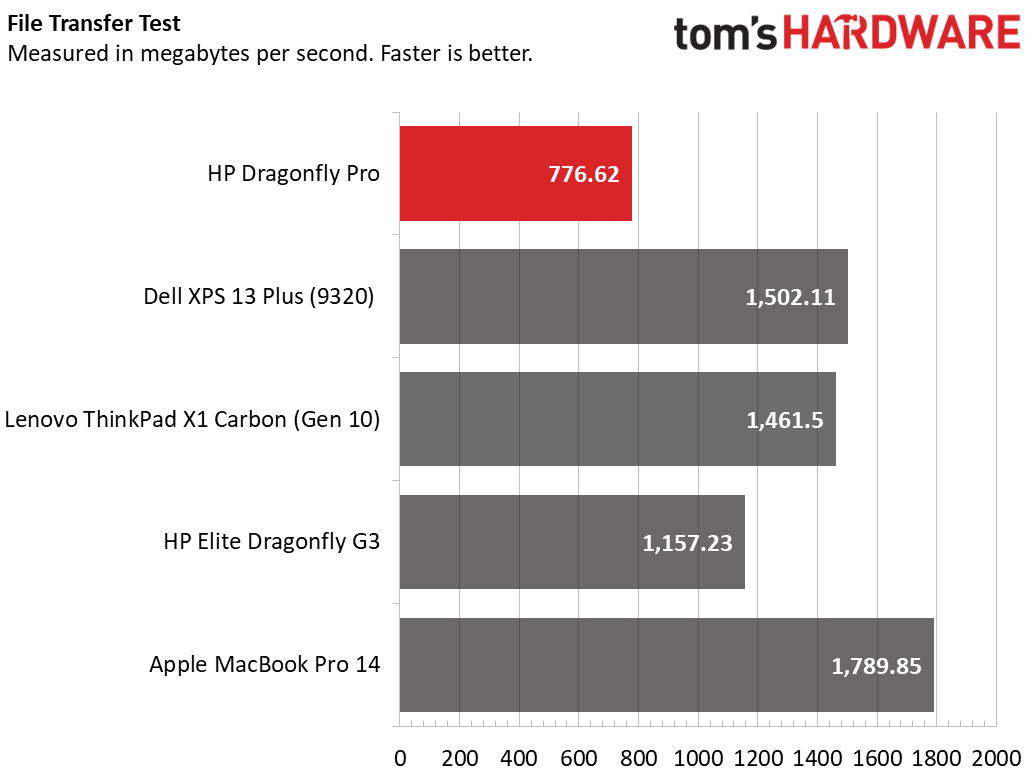
On Geekbench 5, the HP Dragonfly Pro's single-core score of 1,498 wasn't too far off the ThinkPad X1 Carbon (Core i7-1260P) or the Elite Dragonfly G3 (Core i7-1265U), but Apple's MacBook Pro 14 (Apple M2 Pro) was significantly ahead at 1,929 on the same test. And the Dell XPS 13 Plus (Core i7-1280P) also did much better on the Windows side, scoring 1,797.
On the multi-core test, the Dragonfly Pro's 16 threads fared better, with a score of 9,263 beating the ThinkPad X1 Carbon (8,159) and HP Elite Dragonfly G3 ultraportable (6,501). But once again, the XPS 13 Plus (10,621) was better, and the MacBook Pro 14 (15,100) did significantly better. Granted, Apple's laptop is much more expensive at $2,499, but HP repeatedly put the Dragonfly Pro up against the MacBook Pro 14 in its press materials. It's just not up to that pricier competition.
Things looked better overall for HP's Dragonfly Pro in our Handbrake test, which transcodes a 4K video to 1080p. Apple's pricier MacBook Pro 14 finished the job the fastest, taking just 4 minutes and 6 seconds. But the Dragonfly Pro's time of 6:16 was by far the quickest of the Windows machines, with Dell's XPS 13 Plus coming in second at 8:26 and the other two machines taking well over 10 minutes to complete the same benchmark.
On our 25GB file transfer test, the HP Dragonfly Pro landed in last place, moving our files at 776.62 MBps. That's not exactly slow, but everything else here was significantly speedier, with the MacBook Pro (1,789.85 MBps) and XPS 13 Plus (1,502.11 MBps) being the stand-out storage speedsters in this group.
It's also worth pointing out that you better be OK with the Dragonfly's drive speed and capacity (512GB in our review configuration), because on this system the SSD is soldered to the motherboard, just like its RAM.
Our stress test involves running the Cinebench R23 benchmark 20 times in a loop. HP's machine scored 12,544 on the first run. Subsequent runs were lower, dipping below 10,000 for a few runs, before jumping climbing back above that mark and staying there for the second half of the stress test.
During the Cinebench R23 stress test, the Ryzen 7 7736U's eight cores averaged 2.91 GHz. Our testing showed that the CPU package averaged 57.6 degrees Celsius.
Display on the HP Dragonfly Pro
The Dragonfly Pro mostly edged past its peers on our color testing, covering 127% of the sRGB color gamut and 89.8% of the larger DCI-P3 spectrum. That was enough to put it in first place in this test group when it comes to color, although its measured average brightness of 377 nits, while close to HP's claim of 400, was slightly behind the 406 nits we measured on Lenovo's ThinkPad X1 Carbon.
When I watched the trailer for John Wick 4, the screen looked good, with fairly vibrant colors and more than enough brightness for most situations. But as with all glass-covered touchscreens, reflections can be an issue in brightly lit spaces.
Keyboard and Touchpad on the HP Dragonfly Pro
The keyboard on the HP Dragonfly Pro is mostly solid. Its switches feel similar to the Dragonfly Elite G3, and travel is decent for a laptop that's ultraportable-adjacent. Personally, I don't like the all-caps and abbreviated styling on the keys (BKSP instead of backspace). Ironically, it feels more amateurish than "pro," but that's probably something you'll get used to, if you notice it at all.
What's a bit more substantive is the fact that the four extra gray keys on the right edge (most of them launch the myHP software, which we'll touch on shortly) shift four of the keys that are usually on the end of the keyboard one column to the left. Again, this won't bother everyone, but if you're used to having your backspace (I'm sorry, BKSP) key directly under delete/DEL, you might find yourself accidentally hitting a button dedicated to HP's software when you meant to fix a typo.
I had more serious issues with the touchpad. Cursor control was accurate in my time with it, and multi-finger gestures worked well. But it's haptic rather than having any kind of physical click, and I found the feedback set to light by default. This was easy enough to change in settings. But several times when trying to select multiple files and move them from one drive to another or delete them, the touchpad fumbled this basic task.
Either I'd lose the file selection while clicking and dragging, or my file selection would inexplicably change from a few files to everything in the folder. This happened once right after I launched a benchmark, and my attempt to delete old test results while Cinebench launched was interpreted by the laptop as an attempt to delete the benchmark while it was starting up. Perhaps this can be fixed in a software update, but it's been a long time since I've been this frustrated with a laptop's touchpad.
Audio on the HP Dragonfly Pro
The four speakers on the HP Dragonfly Pro are very good, if not quite excellent. When I listened to "Coast to Coast" from Delerium's latest album Signs, I enjoyed the richness of Phildel's vocals and the plinky synths. I didn't notice any discernible distortion when I turned the laptop all the way up. But while the Dragonfly Pro does get reasonably loud for a 14-inch laptop, I couldn't help but think that more sound output was possible. And indeed, when I broke out HP's smaller (and admittedly much pricier) Elite Dragonfly G3, that laptop got noticeably louder when listening to the same song, and also had a bit more high-end clarity.
It's perhaps not fair to compare a $1,400 laptop to one that costs so much more, but you can order a Dragonfly G3 starting under $1,700. And I find it interesting that HP could pack better sound into a smaller package in its Elite line. So while the Dragonfly Pro's speakers are good, they aren't the best.
There is also a section in the myHP app that lets you tweak sound output, which includes both bass, treble, and width sliders as well as an adjustable equalizer. I doubt many people will feel the need to fiddle with it, as the audio balance is generally quite good. It just would be nice to have a little more volume.
Webcam on the HP Dragonfly Pro
The 5MP (2560 x 1920 max resolution) webcam on the Dragonfly Pro is both much better than you'll get with most laptops in this price range, and also oddly disappointing. There's quite a bit of detail (again, compared to 1080p and 720p cameras that are still common in the laptop realm), and the colors appear fairly accurate in the best circumstances.
But the exposure of the camera leans toward the high end by default, which washed out portions of my face under even moderate overhead lights. And in the low light of a late afternoon shifting to evening, the image got quite grainy. This also seemed to affect Windows Hello login, as the laptop appeared to take longer to log me in with my face in low light. At least there's also a fingerprint reader to the left of the power button. And you can play with the camera settings in the myHP software to perhaps achieve a better result. I just don't think you should have to.
To be clear, the webcam here is far from bad. It's just not quite as good as you (or at least I) would expect when reading that a laptop comes with a five-megapixel camera. If you want to look your best – especially in low light – consider getting one of the best webcams we've tested instead.
Battery Life on the HP Dragonfly Pro
At least when it comes to battery life testing, it's clear why HP put the Dragonfly Pro up against the MacBook Pro 14. The Dragonfly Pro lasted 13 hours and 23 minutes on our battery test, which continuously browses the web, runs OpenGL tests and streams video, all while connected to Wi-Fi with the screen set to 150 nits.
That impressive time was enough to soar past the Dell and Lenovo machines by 4-5 hours. Only the MacBook Pro (14:21) and less-powerful and pricier Dragonfly G3 (14:20) lasted longer. And HP's claims that its GaN charger can juice the laptop up to 50% in just 30 minutes is indeed accurate and appreciated.
But tested battery life is only part of the story. While testing the laptop, I noticed it had a tendency to lose battery life at a substantial pace while the lid was closed, and it sometimes wouldn't wake from sleep without a power cycle (holding down the power button until the laptop turned off, then powering back up).
HP sent us a second review unit (ostensibly because the first one, an engineering sample, had other issues as well). But the second model had similar issues. I left that unit in my bag overnight after leaving the office with 95% charge at around 5:30 pm and found the laptop warm in my bag the next morning. Nothing would show on the screen until I powered it off and on again, when the battery meter showed just 8%. Now, HP assures us that this is an issue related to Windows' Modern Standby, and that an updated BIOS that fixes the issue has already been applied to all of the Dragonfly Pro laptops that are being sold.
But HP also sent a BIOS update the afternoon before this review was scheduled to be posted, which is supposedly the version that will be on the retail units. And it assured us that this would fix the battery issues. It did fix the problem with the laptop not waking from sleep, but the battery drain issue while sleeping? I'm not so sure.
In an attempt to replicate the overnight battery drain issue I mentioned above (where the battery meter dropped from 95% to 8% overnight), I charged the BIOS-updated laptop to the same 95% and unplugged it at around 7pm, and shoved it in the same backpack. Taking it out about 12 hours later, the laptop wasn't warm this time, and it came out of sleep without issue. But when I looked at the battery meter, it was at 80%.
A 15% drop overnight is obviously far less dramatic than the 87% fall I saw before the BIOS update, but it still seems rather high for a roughly 12 hours span. If the sleep drain is linear, that's a loss of around 30% a day, and the laptop could go from fully charged to dead after sleeping a little over three days. I have used and owned several laptops in the last few years that could be left for well over a week in a sleep state and still power on when I pick them up. So clearly while the battery drain situation is improved with this BIOS, it's not fixed as far as I can tell to a satisfactory manner.
Now, without access to one of the retail Dragofly Pro laptops, I can't say for sure whether or not they have the same battery drain issues or not. The laptop does charge quickly, to about 50% in a half hour, but if indeed retail laptops are draining in a way similar to my updated review unit, buyers would have to be sure to power off the laptop when not in use, or put a lot of extra battery cycle stress on their machines just due to power drain while sleeping. That's obviously far from ideal.
Heat on the HP Dragonfly Pro
During stress testing, the hottest point on the keyboard using our IR temperature gun was (as is often the case) between the G and H keys, at 41.5 degrees Celsius (106.7 degrees Fahrenheit). The touchpad stayed cooler, at just 31.4 C (88.5 F), and the bottom of the laptop topped out at a reasonable 40.2 C (104.3 F), near the middle of the laptop, toward the back near the intake holes.
Neither the internal components nor the external surface temperature of the HP Dragonfly Pro got particularly warm during our tests. But I did find the fan noise during stress tests to be a bit whiny. The fan isn't particularly loud, nor did it fluctuate in speed and pitch noticeably while running our tests. There is just a sharp fan tone underneath the whirring noise of the air that I didn't like and haven't heard in other laptops lately. Given the reasonable temperatures under heavy load, perhaps HP could fix this in a software update by lowering the maximum speed of the fans a bit.
Tech Support, Software and Warranty on the HP Dragonfly Pro
Aside from the usual Windows 11 cruft (Spotify, WhatsApp, TikTok, ESPN, Amazon and Instagram are all in the Start menu), plus two different programs labeled simply AMD Software, the primary extra app that comes preinstalled on the HP Dragonfly Pro is the myHP program.
The myHP app is tied to the four dedicated buttons that run down the side. And to sum up the software succinctly, it's slow, confusing and mostly unnecessary.
HP says the button below the DEL key (adorned with four small rectangles) offers "one-touch to optimize your device." What it actually does is bring up the homepage of the myHP app, slowly. On average on my review unit, this page took 12 seconds to load for the first time after a reboot. About half of that time was spent waiting for thumbnails to load for guides to help you do truly difficult things, like changing your background or taking a new profile photo (which, as noted earlier, you probably don't want to do with the webcam on this laptop, 5MP or not).
Above these images are big buttons with small text and icons, linking you to the Bang & Olufsen-branded audio controls, plus three other things there are also dedicated keys for: camera/video controls, support, and the programmable key. Yes, 3/4 of the options here are redundant because they also correspond to the three dedicated keys below this one. So yeah, this first button really just launches the myHP app.
Pressing the Camera button actually doesn't bring up the camera settings right away. Rather befuddlingly, it launches the PC Devices section of the myHP program, which happens to have the same menu as the home section, only without the thumbnails to basic guides and settings. And clicking on the Video control button saw me frequently having to wait another 10 seconds for the settings and video preview screen to load. I timed myself just hitting the Start button and launching Windows' own Camera app by typing out the word camera. This took less than four seconds.
Then there is the support/chat button. This brings up access to the 24/7 "concierge" support that comes with the Dragonfly Pro (for the first year, anyway; you'll have to pay $10.99 extra beyond that). You can choose to either chat with a rep via text in the app, or have someone call you. I chose the former, and was exchanging messages with a customer service representative named Jairo, according to my chat log.
After answering his initial question about whether I had the Windows or Chromebook version of the Dragonfly Pro (couldn’t he tell from the app?), I told him about the sleep / battery drain issue I was having with the laptop. He asked me what programs I had installed (and perhaps if I had a game running in the background, which I didn't). Then he asked permission to take control of my machine to run a battery diagnostic and check what processes were running in Task Manager.
After about 45 minutes of chatting and attempted diagnosis, we hadn't sorted out the issue and I needed to leave the office. I was asked what would be a good time the next day for HP's representatives to call me to discuss the issue further. I told the agent 3 p.m. would be best, and sure enough, I received a phone call at 3:06 p.m. the next day. By then, though, I had confirmed the battery issue with HP's internal PR representatives, and I didn't recognize the number or remember that I'd asked them to call me at that time, so I didn't take the call.
In short, I was thoroughly satisfied with the service. But of course, the laptop had not yet gone on sale when I used HP's chat and phone service, so it was probably clear I was either a reviewer (or perhaps someone at HP) testing the service. So I can't vouch for what things will be like weeks or months from now. HP does make clear, though, that the service is 24/7, so if you have a PC-related problem big or small with your Dragonfly Pro, someone should be ready to speak or chat with you whenever you need help. I'm sure that is an appealing selling point for someone.
Lastly, there's the programmable button, which lets you assign two or more programs, websites, files or folders to launch with a single press. It would be nice if there were more than one of these so freelancers could, say, program different buttons for different jobs, or one for work and one for play/chat/media consumption.
HP sells the Dragonfly Pro with a one-year warranty and a year of 24/7 chat support included. Beyond the first year, you can extend the support, warranty, as well as once-per-year spill / drop protection for the device for $10.99 a month for up to three years.
HP Dragonfly Pro Configurations
As noted earlier, the Dragonfly Pro comes in just two configurations, because HP says options overwhelm some people. Both configurations ship with the same AMD Ryzen 7 7736U CPU and 400-nit touchscreen. The $1,399 model we tested has 16GB of RAM and 512GB of NVMe storage, while a $1,549 option doubles the RAM and storage to 32GB and 1TB, respectively. At this price, I would like to see storage stepped up to 1TB for the base unit and 2TB for the $1,549 option. Again, be sure the model you order has enough storage and memory, because both are soldered onto the laptop's motherboard with the Dragonfly Pro. Given that, there's nothing to discuss when it comes to upgradability.
Conclusion
The biggest issue with my review unit (actually, units) is the unexpected battery drain while sleeping. HP assures us that an updated BIOS will be in place for all units sold, and it sent a version of that BIOS to us the night before the laptop went on sale. For our unit it least, it lessened the issue, but didn't fix it, leading to a 15% battery loss in about 12 hours of sleep. There's no real way for us to tell whether or not this issue will also affect a Dragonfly Pro that you might buy. Otherwise, the laptop is attractive and feels premium, with decent performance and over 13 hours of runtime on our battery test. That puts it ahead of many laptops in its class – particularly those running Intel's competing P Series CPUs.
The Dragonfly Pro's main differentiating feature is its 24/7 support, and at least in my pre-launch experience that worked well. But it seems likely that's only going to appeal to a niche of either novice laptop users in general (who probably don't need this much CPU performance), or people who for some reason switched from Macs at arguably the worst time in history to do so.
HP says the laptop's target demographic is freelancers, but I'd argue most people successful enough to be able to afford a $1,399 laptop as a freelancer are probably self-sufficient enough to not need one-button access to tech support for basic tasks. And as someone who used to be a freelance writer for several publications, I don't think a 3.5-pound laptop is ideal for those who often bounce between gigs and coffee shops when there are significantly lighter ultraportable laptops that are still premium and can cost significantly less.
Then there's the myHP app and the group of dedicated buttons designed to launch it. Dedicated buttons can be nice. But when they're there to launch an app that's slower to load than most anything else on your system, and doesn't offer enough useful functionality to justify the existence of its three buttons, it's hard to argue for their usefulness.
You could just have one button that launches the app and then one click would get you everywhere else – after waiting several seconds for the software to fully load, that is. At least there's the programmable key, which you can set to launch multiple programs, web pages, files and folders with a single press. Having a couple more of those and the dedicated support button would be a better use of these dedicated keys. But really, most people would be better off choosing a laptop that doesn't feel so half-baked underneath its pretty outer shell.
MORE: Best Ultrabooks and Premium Laptops
MORE: How to Buy a Gaming Laptop
MORE: Best Gaming PCs
After a rough start with the Mattel Aquarius as a child, Matt built his first PC in the late 1990s and ventured into mild PC modding in the early 2000s. He’s spent the last 15 years covering emerging technology for Smithsonian, Popular Science, and Consumer Reports, while testing components and PCs for Computer Shopper, PCMag and Digital Trends.
-
g-unit1111 I have an HP laptop right now. It's decent, it gets the job done. But there's definitely much better options out there.Reply -
-Fran- So the only "major" gripe is the battery drain when you put the laptop to sleep... That's it?Reply
Also, I am starting to tell people to forgo using USB-A and go all in on USB-C with adapters for their USB-A ports. This is the same thing with CD/DVD readers on laptops and computers: let's just get moving on with the times. USB-C connectors are what we need NOW and not tomorrow. Praise laptops for packing a lot of them and treat as a minus going forward having USB-A ports instead.
As for my take on the laptop itself, well, my GF has an HP Envy with a 7th gen i5 and a 350MX; quite good unit for the price back then, although I had to change its battery as the previous one got "fat". Anyway, still horsing along after swapping the original SSD for a nice Crucial P5. This thing strikes me as a better unit from the "grunt" and battery life perspective, but unnecessarily bulky/bigger.
If Aya can pack the 6800HS/773xU in a handheld, I don't see why HP can't put it in an ultra light like the Envy line. Missed opportunity.
Regards. -
saunupe1911 This white laptop trend needs to STOP!!! How about Navy blue...hell I would take red or green. But this white is not the color for a tool.Reply
I truly hope Asus stop it with the G14 especially. -
TechieTwo HP doesn't seem to have a very good handle on the laptop consumer market needs/desires IME. This has been an issue for years.Reply
The constant battery drain problem goes back at least three generations of CPUs. HP refused to even acknowledge the issue until it was documented by reviewers. I do not know if they ever provided a fix for older model laptops as BIOS updates did not fix the problem. -
dimar May I recommend including ease of disassembly/service. For example I've seen HP and Asus laptops where you need to remove the motherboard to change the CMOS battery or a hard-drive.Reply
Also HP uses super cheap plastic that bends and breaks easily. -
10tacle Replydimar said:May I recommend including ease of disassembly/service. For example I've seen HP and Asus laptops where you need to remove the motherboard to change the CMOS battery or a hard-drive. Also HP uses super cheap plastic that bends and breaks easily.
Well if you are that curious about the tear down/upgrade/replace situation, download the service manual from HP's support site. That's what I always do before choosing a new laptop. As for HP's cheap plastic. I can attest to that having bought one of their ~$500 (USD) mid-ranged ones 15" last year. When taking it apart I had to be very careful with removing the bottom cover to upgrade the M.2 SSD and memory. It felt like one slight pull in the wrong direction would split it in half. Never had that with my Dell and Lenovo laptops along the same tier range. Also, when opening the lid, it is very flimsy. Finally, I will say that only with HP have I had cooling fans fail far too early, like within the first 1-2 years of ownership. It is not an uncommon issue. -
IT34 Battery drain in sleep mode is a Windows problem not really an HP problem? Not sure why criticize this laptop for something that's a Windows issue?Reply

